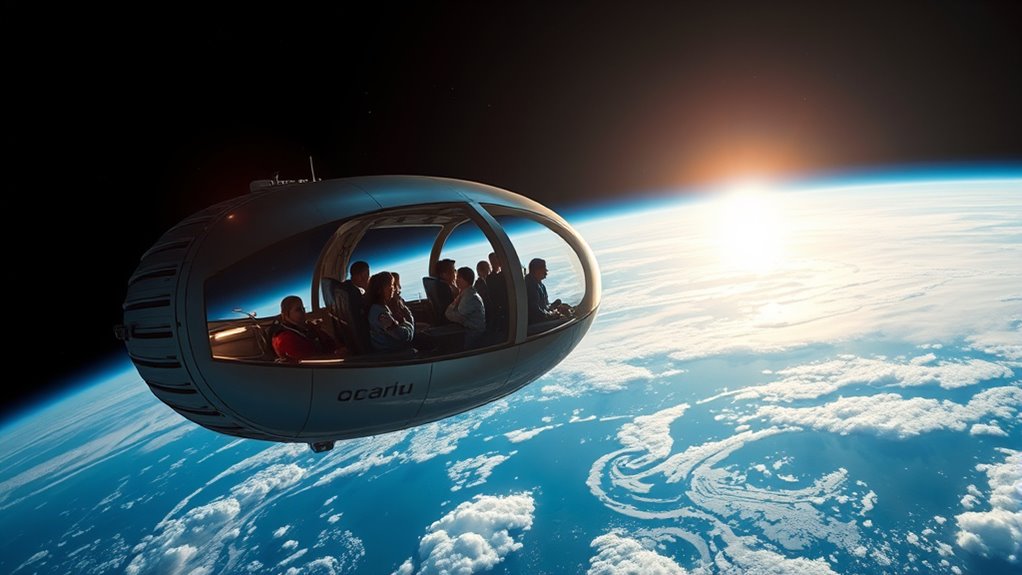By 2025, space tourism will become more accessible and affordable, making it a reality for more people. Expect shorter suborbital trips, orbital stays, and new adventure experiences, all supported by technological advancements that lower costs and boost safety. Private companies and government support will expand infrastructure and options, turning space travel from a luxury into a mainstream activity. Want to discover how these changes will shape your next space adventure? Keep exploring to find out more.
Key Takeaways
- Increased number of commercial spaceflights offering suborbital and orbital experiences.
- Lower launch costs driven by reusable spacecraft, making space tourism more affordable.
- Enhanced safety and comfort features improve overall passenger experience.
- Broader range of space activities, including media, research, and orbital stays.
- Growing public interest and industry investments accelerate accessibility and mainstream adoption.

Have you ever wondered how close space tourism is to becoming a mainstream adventure? In 2024, the market was valued at around USD 1.3 billion, and it’s only expected to grow rapidly. By 2030, analysts project the industry will reach approximately USD 6.7 billion, driven by a compound annual growth rate of 31.6%. This surge stems from increasing investments by private companies and significant advancements in reusable rocket technology, which are lowering costs and making space travel more feasible for a broader audience. North America currently dominates the market, accounting for over 38.9% of the global share in 2024, with the U.S. leading the charge. The region’s investment in infrastructure and technology, along with supportive regulations, fuels its prominent role in shaping the future of space tourism.
Technological breakthroughs play a *vital* role in transforming space travel from an exclusive experience into something more accessible. Reusable spacecraft, pioneered by companies like SpaceX, are drastically reducing costs associated with launching and operating space vehicles. These innovations, along with improvements in propulsion systems, make space trips more efficient and less expensive. As costs continue to drop—potentially by 10% annually—more people will find space tourism within reach. The shift toward affordability is expected to increase demand, especially as firms expand their service offerings beyond just short suborbital trips to include longer orbital stays, research missions, and even media productions. These diverse offerings will cater to a wide array of customers, from adventure seekers to scientists and educational groups.
Investment trends are fueling this rapid expansion. Billionaires and private companies like Blue Origin and SpaceX are pouring funds into developing new spacecraft and infrastructure, fostering a competitive environment that spurs innovation. Governments are also playing a supportive role, providing regulatory clarity that helps stabilize the industry and encourage further growth. The combined efforts of private and public sectors are creating a fertile landscape for market expansion and service diversification. The United States, in particular, is set to see significant growth, with the market estimated to reach USD 757.9 million in 2025 and projected to grow to USD 3.5 billion by 2035.
Public interest in space exploration is soaring, driven by technological advancements that make space travel more accessible and safer. People are *enthusiastic* to experience the thrill of floating in zero gravity or viewing Earth from orbit. As safety and comfort improve, space tourism will become an increasingly attractive option for adventure travelers, researchers, and curious civilians alike. In 2025, expect to see more launches, more accessible prices, and a broader range of space experiences that could soon shift space tourism from a luxury to a regular adventure for many. According to recent forecasts, the industry is expected to see a steady increase in customer demand, with market expansion opening new opportunities for various service providers.
Frequently Asked Questions
What Are the Safety Protocols for Space Tourists?
You should know that safety protocols for space tourists include strict vehicle inspections, emergency backup systems, and radiation shielding to protect you during your trip. You’ll undergo thorough medical screenings and training to prepare physically and mentally. Additionally, cybersecurity measures safeguard your data, and life support systems ensure a safe environment. These protocols work together to minimize risks and keep you safe throughout your incredible journey.
How Much Does a Space Tourism Trip Cost?
You’re asking about the cost of space tourism, and it’s no small change! For suborbital flights, you’re looking at around $250,000 to $450,000 per seat, giving you a few minutes of weightlessness. Orbital stays on the ISS can run about $55 million, while lunar trips or space hotels could cost hundreds of millions. It’s a high-stakes adventure, but the experience is truly out of this world.
Are There Age Restrictions for Space Tourists?
Right now, there aren’t universal age restrictions for space tourists, but your age might matter depending on the company and legal regulations. You need to be in good health and meet certain physical standards, which can vary. Space agencies and private companies focus more on your physical fitness and medical readiness rather than age alone. So, if you’re healthy and meet the criteria, age might not be a barrier to your space adventure.
What Training Is Required Before Going to Space?
Imagine you’re preparing for a space trip like the upcoming Virgin Galactic flights. Before you go, you’ll undergo astronaut-style training, including spacewalk techniques and spacecraft operations. You’ll learn to handle microgravity, simulate launch conditions in centrifuges, and prepare for emergencies. The training varies from brief sessions for suborbital trips to longer programs for orbital flights, ensuring you’re physically and mentally ready for the challenges of space travel.
Will Space Tourism Be Eco-Friendly and Sustainable?
You might wonder if space tourism will be eco-friendly and sustainable. While current emissions are low, they could increase as demand grows. Companies are developing cleaner fuels and greener propulsion methods, but challenges remain. Governments are working on regulations, and technological innovations are promising. If the industry balances growth with environmental responsibility, space tourism could become more sustainable, helping protect our planet while still offering incredible experiences.
Conclusion
By 2025, space tourism will feel like stepping onto a new frontier, a thrilling adventure written in the stars just for you. Imagine floating in weightlessness, gazing down at Earth’s swirling tapestry of blues and greens—your own cosmic postcard. It’s not just a trip; it’s a leap into the great unknown, where dreams become your new reality. Get ready to turn the universe into your backyard, and make those celestial dreams come true.









